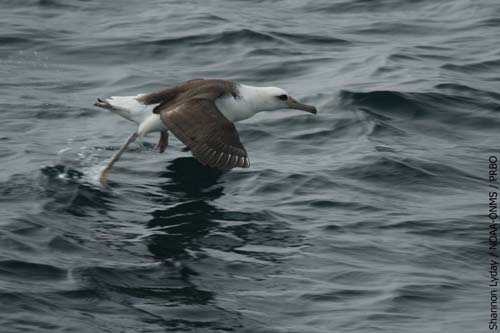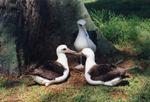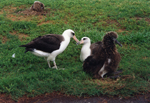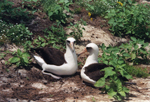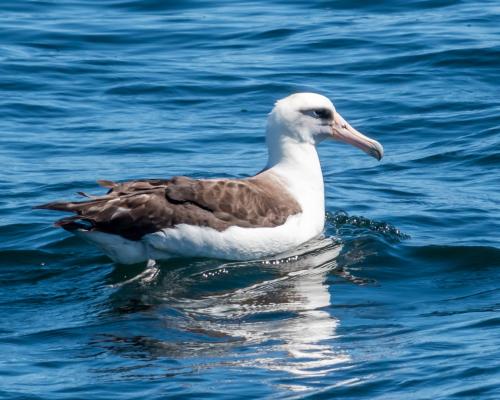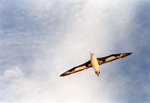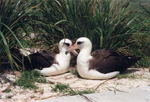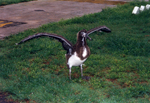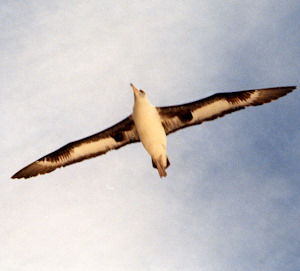
Laysan Albatross
Phoebastria immutabilis
Overview
Key Features:
The Laysan Albatross is two-toned, with a dark back and white belly and head, which distinguishes the Laysan from other albatrosses.Similar Species:
Black-footed Albatross (Phoebastria nigripes)Primary Common Name:
Laysan AlbatrossSynonymous name(s):
Diomedea immutabilisGeneral Grouping:
Seabirds and shorebirdsGeographic Range:
Northern Pacific Ocean, from Japan to Alaska to California
The Laysan Albatross ranges widely across the northwestern and northeastern Pacific, from Japan to Alaska to California, usually far offshore, at least 20 to 30 km during nonbreeding months (July – October). In Monterey Bay their numbers peak in January and February.Habitats:
Continental shelf, exposed rocky shore, exposed sandy beachesNotes:
Open and exposed, sandy coast for breeding purposes only. Well offshore when not breeding.Abundance:
Relative Abundance:
Phoebastria immutabilis breeds at 16 sites (nine with populations of greater than 100 pairs), mostly in the Northwestern Hawaiian Islands, with additional small colonies in Japan and Mexico. The population is estimated to be 1,180,000 with 590,900 breeding pairs. The largest colony is at Midway Atoll, where 71% of the world's population nests, followed by Laysan Island, also in the Northwestern Hawaiian Islands. The population at monitored colonies increased between 1980 and 1995 but has never reached the numbers observed prior to large-scale harvests for feathers in the early 1900s. There was a 32% decline during 1992-2002 (3.2% per annum) of birds breeding on the Northwestern Hawaiian Islands, though data from 2004 and 2006 indicate that the breeding population then rebounded, and that the overall population trend for 1992-2005 is stable. In January 2008, 452,609 breeding pairs of Laysan Albatross were nesting on the three islands of Midway (Sand: 274,043, Eastern: 176,561; Spit: 2,005). A population began nesting in Mexico in the 1980s and has been increasing since then. In 2003 the Laysan Albatross was classified as 'Vulnerable' by the IUCN using information from the Hawaiian Islands showing declines of at least 30 percent over three generations.Species Description:
General:
Albatrosses are distinguished from all other seabirds by their large size, long slender wings, large bills (102 to 113 mm/4 to 4.5 in), and their soaring, steady flight with seemingly endless gliding. When sitting on the water they lose their graceful appearance and float like a giant gull. Albatrosses cannot take off in calm air but must run across the surface of the water, into the wind to become airborne. This is also true of the time they spend on land, needing to run across the sand into the wind, flapping madly to gain altitude. The Laysan Albatross is usually easy to identify and separate from the other albatrosses because of coloration: upper wings, mantel, back, upper rump and tail are blackish-grey. The head, lower rump and underparts are white. Adults have a blackish smudge around the eye. The bill is pinkish-yellow with a grey hooked tip, legs are a light grey and feet are webbed and pale pink. The ventral side of the fairly narrow wing is white with black margins and variable amounts of black on the underwing coverts. The juveniles are similar except their bill is more grey and there is no white in the upper rump. The Laysan Albatross is approximately 81 cm. long (32 inches) with a wing span of about 208 cm (82 inches). It weighs approximately 6.6 lbs (3,000 grams). It is slightly smaller and slimmer than the Black-footed Albatross.Distinctive Features:
Phoebastria immutabilis has a blackish-grey back, mantel, upper wings, upper rump and tail with white head, lower rump, and underparts. Pinkish-yellow bill with grey tip, blackish smudge around eye, legs and feet grey to pale pink. In flight it soars for long periods without wing beats.Size:
The Laysan Albatross measures approximately 81 cm (32 inches) in length and has a wingspan of 198 to 216 cm (78 to 89 inches). It weighs 2.7 to 3.2 kg (6 to 7 pounds).Natural History:
General:
The Laysan Albatross is an open ocean species, coming to land exclusively to breed in October and then incubating, brooding and raising a chick from November until June. It is an annual breeder, though like other albatross species, each year a portion of birds will skip a breeding season. Adults care for their single chick from hatching in February or March until June or July when the chick is old enough to survive on its own. Nests vary from a simple scoop in the sand to more elaborate nests where vegetation allows. Its lifespan varies from 12 to 40 years usually, although a 55 year old Laysan Albatross has been recorded breeding (USFWS unpublished data). The largest colony of Laysan Albatrosses is at Midway Atoll in the Hawaiian Islands National Wildlife Refuge and numbered over 450,000 pairs in 2008.Predator(s):
The only known native predator of Black-footed and Laysan Albatrosses in Hawaii is the tiger shark (Galeocerdo cuvieri), which preys upon fledglings during their first incursions to sea. The endemic Clarion Raven (Corvus corax clarionensis) and the Clarion Racer (Masticophis anthonyi) may be significant predators on Clarion Island, Mexico (Bill Henry pers. comm.).Invasive Predators
Non-native mammalian predators (e.g., dogs, cats, pigs, mongooses, and rats) limit the size and productivity of several breeding colonies and may restrict the reoccupation of some historical sites. On the main Hawaiian Islands, feral and domestic cats and dogs kill albatrosses, and few if any of these colonies would be viable without predator control programs such as fencing and trapping (USFWS 2005). Big headed ants are also a threat to young chicks.
Prey:
The Laysan Albatross feeds in pelagic waters, mainly on flying fish (Exocoetidae) egg masses and adults, and secondarily squid (Order Teuthoidea). It will also consume crustaceans, other invertebrates and carrion. It has been described as a floating pig by one author for its habit of taking kitchen scraps from ships. It will also consume floating debris, including plastics.Feeding Behavior:
Carnivore, Omnivore, ScavengerNotes:
The Laysan Albatross seizes prey while floating on the surface (i.e. it does not dive into the water while in flight as pelicans do) or by making a shallow surface dive. The Laysan Albatross, having high levels of rhodopsin in its retina, is primarily a nocturnal feeder, seizing prey at the surface, taking almost anything that floats, or making a shallow surface dive. They will follow ships to eat anything that is discarded. They scavenge at pelagic gillnets and steal bait from longlinesSeasonal Behavior
July - September
Migration:
The Laysan Albatross spends July, August and September far offshore in the Northern Pacific Ocean, ranging from Alaska to California and Japan. It has no set migration pattern but seeks squid and flying fish and lesser crustaceans. They also follow fishing vessels eating discarded scraps.October - November
Migration:
Three year old Laysan Albatrosses return to their breeding site, but will not mate for the first time until they are seven or eight years old. They will, however, begin to form pair bonds with a mate that they will keep for life. Low, flat islands in the open sea is the preferred breeding/nesting area and they always return to the area where they hatched. The Northwestern Hawaiian Islands is the breeding site for over 90% of the Laysan Albatross population.Reproduction:
Adults seek mates when they are seven or eight years old and begin an elaborate courtship ritual including bill snapping, bowing, pointing the bill skyward, neck thrusting, preening, groaning , and stepping in a dance that can have up to 25 ritualized movements. It is more elaborate and faster paced than the routine of the Black-footed Albatross. Both male and female participate and mirror each others movements. This unique method of bonding lasts up to two months. During this time the nest site is selected and scraped and groomed by both sexes. Previously bonded pairs may lay one egg as early as late November.Feeding:
During this early part of the breeding season the adults return to sea to feed whenever they please.November - January
Reproduction:
The female Laysan Albatross lays one egg in a scrape. Both parents will incubate the egg, never leaving it exposed. The egg is incubated for approximately 65 days. However the male incubates more than the female, to allow the female foraging time to recoup nutritionally after the stress of egg-laying. During December the number of incubating males outnumber incubating females 15:1. If the egg is infertile or breaks during incubation, re-laying will not occur that year.Feeding:
Parents take turns going to sea to feed. The average shift time that each parent spends incubating is 18 days. Mates can wait on the nest up to 38 days, going without food or water, before they are relieved by their mate.January - March
Reproduction:
Chicks hatch from mid-January through mid-February. (Late season chicks have a higher mortality.) The chick is never left alone for the first 20 days or so, after which both parents leave the nest, returning to feed the chick in one, two or three days. The chick does not move from its nest site, even if it is raining and shelter is nearby.Feeding:
The chick is fed by regurgitation, first on the parents' stomach oil. Then parents go to sea looking for fish and small crustaceans. When the returning parent arrives at the nest the chick pecks at the returning parent's bill until the parent opens its bill. The chick sticks its bill but not its head inside the parent\'s bill stimulating the stomach contents to be brought up. Often, instead of fishes, squid and crustaceans, the parents have been attracted to colorful plastics floating in the ocean, which is regurgitated for the chick. Many chicks, full of plastic but no real food, die of starvation.April - May
Feeding:
During these months the parents continue to feed their chick, leaving their chick for longer periods of time while they are at sea foraging. The rich squid and stomach oil from the parent is filled with fatty acids and nutrients which sustain the chick for numbers of days between feedings. The chick begins to flap its wings vigorously, and step around the nest, developing musculature for flight. Fledging occurs five to six months after hatching, from mid-June through late July.June - July
Migration:
Parents leave the breeding grounds, abandoning their chick. The parents separate and return to sea to feed.Reproduction:
Sub-adults return to their natal colony at three to five years of age but do not mate or nest until 6 to 8 years of age.Feeding:
Once the parents have returned to sea the chicks remain at the nest site waiting for a parent. They complete their juvenile plumage and practice take-offs. Hunger eventually drives the full grown chick to leave the nest area and wander to the ocean\'s edge and take flight. It will spend the next three years at sea feeding and maturing.Issues
Monterey Bay National Marine Sanctuary:
Entanglement in debris and fishing gear such as pelagic and demersal longline fishing gear. In 2001 8,000 or more Laysan Albatross were killed in longliners in the North Pacific. In the Bering Sea and the Gulf of Alaska demersal longlines kill approximately 700 birds per year. By catch rate in Japan and Taiwan are unknown. Other threats include organochlorine contamination, plastic ingestion, lead poisoning, oiling, human disturbance and conflicts with aircraft. Up to 10,000 chicks are poisoned from lead-based paint from 95 discarded buildings left by the Navy after WWII in the northern Hawaiian Islands . At this writing funds are not available for clean-up efforts. Studies show that as many as 5% of hatched chicks will die from lead poisoning. Also 90% of Laysan chicks that were examined had plastic in their guts. It is known that ships throw overboard over 5 million plastic containers daily and commercial fishing ships add over 175,000 tons of plastic to the ocean annually. Additionally, avian pox virus threatens chicks on Midway and on the Main Hawaiian Islands where mosquitoes are the vector. Dogs, cats, mongooses, and rats kill adults and chicks on populated islands. Big headed ants are also a threat to young chicks' and lastly, in the Northwestern Hawaiian Islands Verbesina encelioides, an aggressive and invasive weed, degrades nesting habitat.References
- BirdLife International, Laysan Albatross - BirdLife Species Factsheet. World Wide Web electronic publication. http://www.birdlife.org/datazone/species/index.html?action=SpcHTMDetails.asp&sid=3958&m=0
- Ehrlich, P., D.S. Dobkin, and D. Wheye. 1988. The Birders Handbook: A Field Guide to the Natural History of North American Birds. Simon & Schuster Inc., New York. 785 p.
- International Union for Conservation of Nature and Natural Resources, The IUCN Red List of Threatened Species 2008, Phoebastria immutabilis. World Wide Web electronic publication. http://www.iucnredlist.org/details/144905
- Midway Atoll National Wildlife Refuge, Birds of Midway – Laysan Albatross. U. S. Fish & Wildlife Service, National Wildlife Refuge System. World Wide Web electronic publication. http://www.fws.gov/midway/laal.html
- NOAA. 1994. Beached marine birds and mammals of the North American West Coast: a revised guide to their identification. NOAA Sanctuaries and Reserves Division, U.S. Department of Commerce
- Roberson, D. 2002. Monterey Birds 2nd edition. Monterey Peninsula Audubon Society, Carmel, CA. 536 p.
- Sibley, D.A. 2000. The Sibley Guide to Bird. Alfred A. Knopf, Inc. 545 p.
- Tarry, E. 2008. Laysan Albatross, New England Seabirds,. http://www.neseabirds.com/Midway/laysan.htm
- U.S. Fish & Wildlife Service, 2000. Midway Atoll National Wildlife Refuge, U.S. Fish & Wildlife Service, Department of the Interior. 16 p.
Related Information
Photo Library
Click on an image below to view a larger version in the SIMoN Photo Library. You will also be able to view important information on each photo such as photographer, date, caption and more
